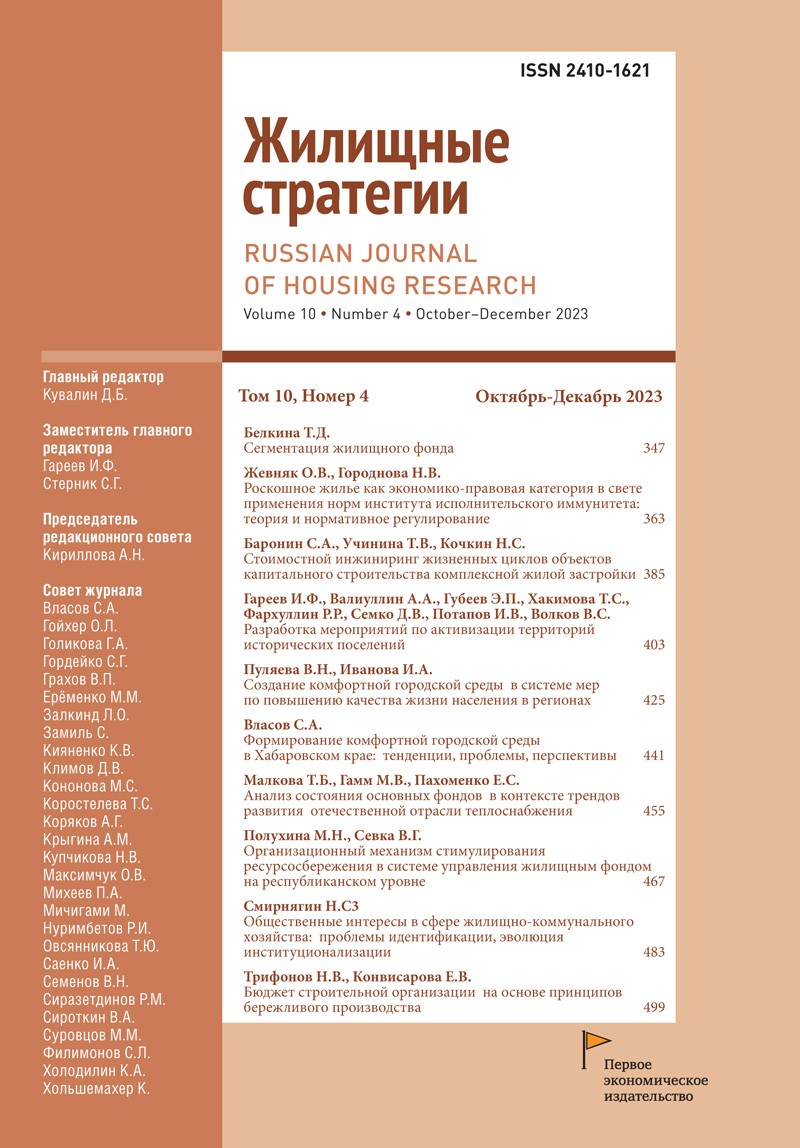Fixed assets of heat supply in the context of trends in the development of the domestic heat supply industry
- 作者: Malkova T.B.1, Gamm M.V.1, Pakhomenko E.S.1
-
隶属关系:
- Moscow State University of Civil Engineering (MGSU) National Research University
- 期: 卷 10, 编号 4 (2023)
- 页面: 455-466
- 栏目: Articles
- URL: https://journals.eco-vector.com/2410-1621/article/view/625293
- DOI: https://doi.org/10.18334/zhs.10.4.118906
- ID: 625293
如何引用文章
详细
The study is devoted to the analysis of fixed assets of heat supply organizations in the context of trends in the development of the domestic heat supply industry. The authors have identified the real problems and challenges of domestic heat supply. The authors have identified the directions of development to ensure an increase in the reliability and efficiency of the heat supply industry. The authors analyzed the trends in the development of the industry, including the priority of the development of cogeneration, enshrined in the Energy Strategy of the Russian Federation, and reviewed the previous period of “boilerization” of the country's territories. Operational efficiency reflects the ability of an organization to effectively perform its functions and achieve its goals in heat supply. The key components determining the operational efficiency of heat supply organizations are technical efficiency, which expresses the state of fixed assets (primarily heat supply sources and heating networks), energy efficiency, financial and managerial efficiency. Heat supply in Russia is traditionally divided into two segments: centralized and decentralized. In the Russian heating sector, various sources of thermal energy are represented, depending on the density of development, climatic features of the region, availability of natural resources and historical features of the region's development. A significant part of heat supply organizations at this stage of development is characterized by low operational efficiency, expressed in a high level of depreciation of fixed assets, low energy efficiency, low motivated managerial efficiency, expressed in the lack of coordination between heat supply organizations operating within the region and insufficient measures to modernize and replace fixed assets.
作者简介
Tatiana Malkova
Moscow State University of Civil Engineering (MGSU) National Research University
Email: mtb37@yandex.ru
Mark Gamm
Moscow State University of Civil Engineering (MGSU) National Research University
Email: aurumark@mail.ru
Elena Pakhomenko
Moscow State University of Civil Engineering (MGSU) National Research University
Email: tolstykh.elena@mail.ru
参考
- Лаврентьева М.С., Туркин М.М. Энергетическая безопасность как один из основополагающих элементов национальной безопасности Российской Федерации // Союз криминалистов и криминологов. – 2022. – № 2. – c. 67-73. – doi: 10.31085/2310-8681-2022-2-208-67-73.
- Васильева В.В. Топливно-энергетический комплекс России: проблемы и перспективы развития // Научное обозрение. Педагогические науки. – 2019. – № 2-2. – c. 26-31.
- Семикашев В.В. Теплоснабжение в России: текущая ситуация и проблемы инвестиционного развития // Эко. – 2019. – № 9(543). – c. 23-47. – doi: 10.30680/ECO0131-7652-2019-9-23-47.
- Число источников теплоснабжения по мощности. ЕМИСС Государственная статистика. [Электронный ресурс]. URL: https://www.fedstat.ru/indicator/34076 (дата обращения: 13.07.2023).
- Богданов А.Б. Почему в России такое дорогое тепло? // Тепловая энергетика. – 2014. – № 5(14). – c. 6-7.
- Доклад о состоянии теплоэнергетики и централизованного теплоснабжения в Российской Федерации в 2020 году. Minenergo.gov.ru. [Электронный ресурс]. URL: https://minenergo.gov.ru/node/22832 (дата обращения: 13.07.2023).
- Гимади В.И. Смена приоритетов в тарифном регулировании отраслей ТЭК России // Энергетическая политика. – 2014. – № 4. – c. 3-11.
- Энергетическая стратегия России на период до 2035 года. Minenergo.gov.ru. [Электронный ресурс]. URL: https://minenergo.gov.ru/sites/default/files/documents/11/10/1920/document-66308.pdf (дата обращения: 13.07.2023).
- Протяжённость тепловых и паровых сетей в двухтрубном исчислении, нуждающихся в замене. ЕМИСС Государственная статистика. [Электронный ресурс]. URL: https://www.fedstat.ru/indicator/33899 (дата обращения: 13.07.2023).
- Емельянов А.А., Семичева Н.Е. Повышение надёжности существующих тепловых сетей // Поколение будущего: взгляд молодых ученых-2020: Сборник научных статей 9-й Международной молодежной научной конференции. Том 4. Курск, 2020. – c. 266-269.
- Закомолдина Е.С., Плотникова Л.В. Изоляция тепловых сетей // Актуальные научные исследования в современном мире. – 2021. – № 1-1(69). – c. 155-159.
- Попова Н.М., Таран В.Е., Петрикеева Н.А., Чудинов Д.М. Оценка технического состояния тепловых сетей в РФ // Градостроительство. – 2021. – № 1(22). – c. 16-21.
- Свистунов А.В., Куркина А.Д. Развитие государственно-частного партнерства на основе концессий в сфере теплоснабжения жилого фонда в интересах потребителя // Жилищные стратегии. – 2018. – № 1. – c. 79-94. – doi: 10.18334/zhs.5.1.39023.
- Апарина У.А. Условия успешной реализации концессионных соглашений для объектов теплоэнергетических предприятий небольших муниципальных образований // Экономика, предпринимательство и право. – 2019. – № 1. – c. 45-54. – doi: 10.18334/epp.9.1.40636.
- Мушкетова Е.А., Ефимова Е.В. Проблемы мониторинга и контроля поверочных данных манометров тепловых сетей // Информатизация в цифровой экономике. – 2021. – № 2. – c. 63-70. – doi: 10.18334/ide.2.2.113383.
补充文件








